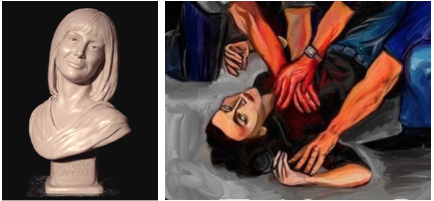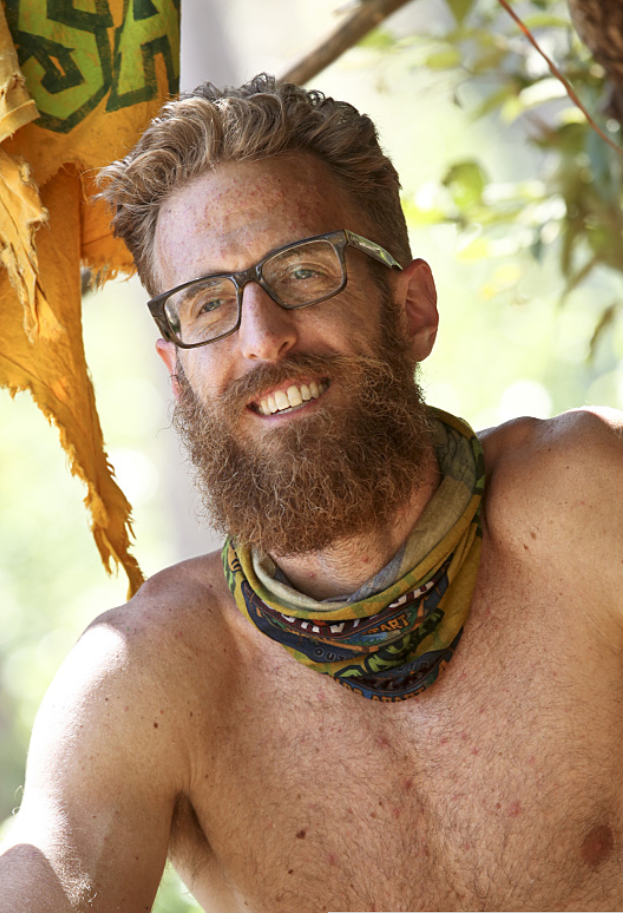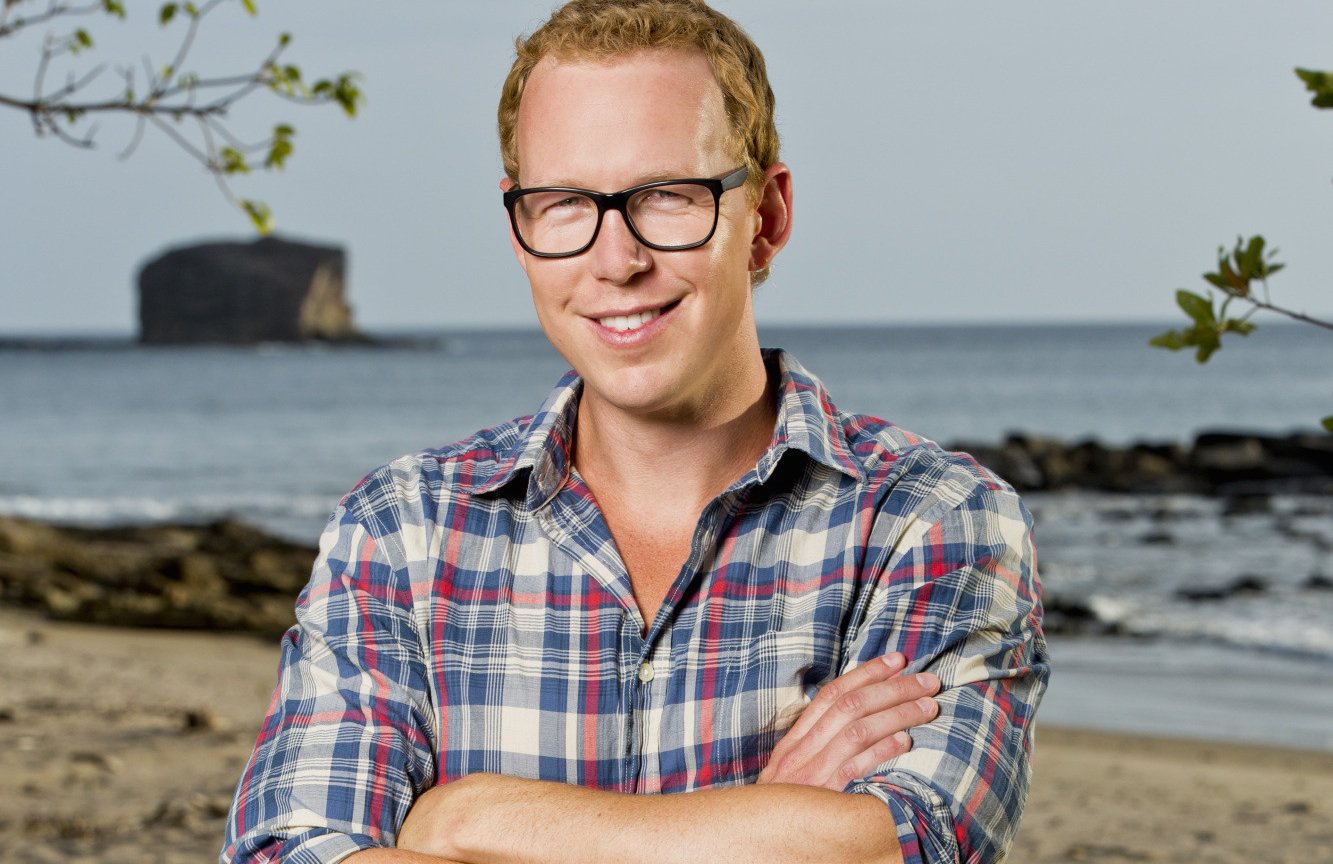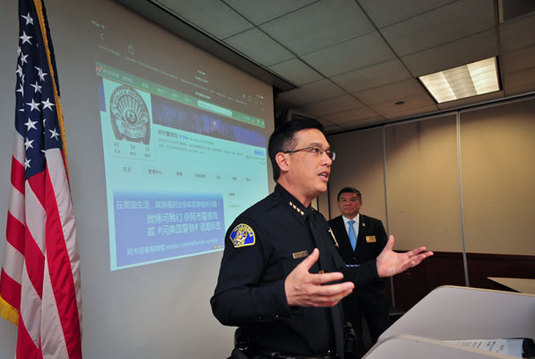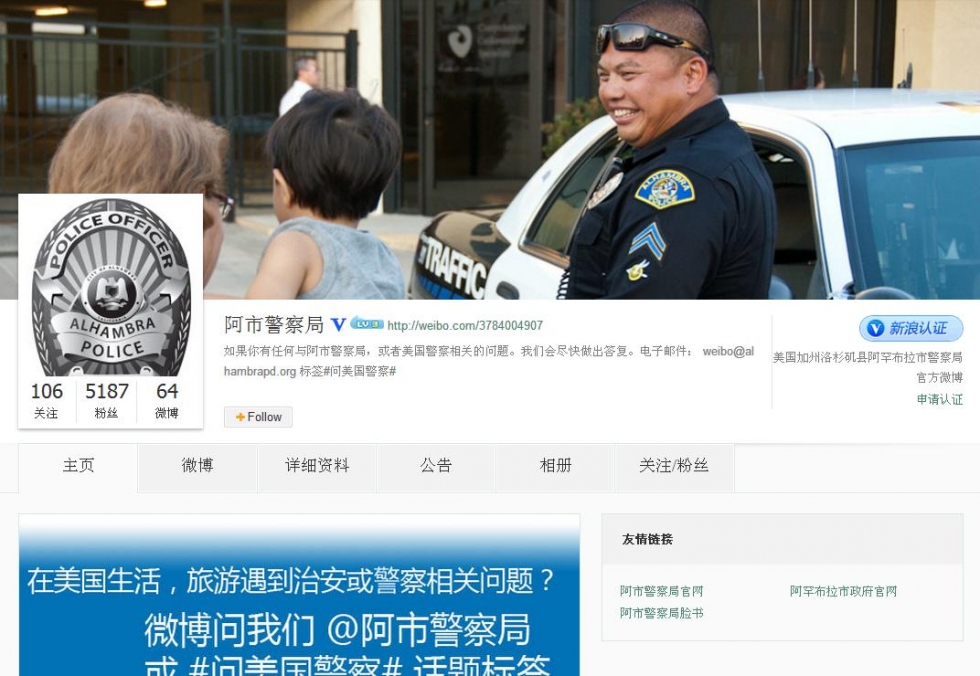The following is the second part of an interview with Aca-Fan and Survivor contestant Max Dawson conducted by my son, Charlie Jenkins. The text below includes his introduction and conclusion.

A Max Dawson campaign poster made by his fan @robstaboobuzzer
At the end of Part 1 of this interview, Max and I were talking about how Survivor has brought some of the contestants to a dark place this season. I cannot fairly and completely represent all of the points of view involved without going on for several pages and I don’t want to take the spotlight off of our guest Max (who had already been voted off). Read HERE, HERE HERE AND HERE for more details.
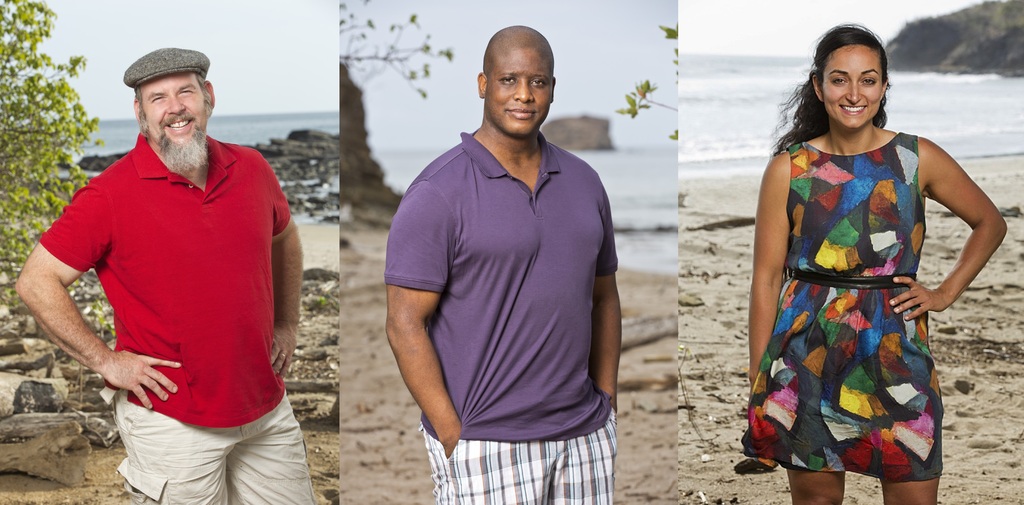
Dan, Will and Shirin (early on)
But the short version is, there were two male contestants – Dan Foley, 47, a postal worker from Gorham Maine and Will Simms II, 41, a bartender/singer from Sherman Oaks, California – who were caught on camera saying vicious things to and about a female contestant - Shirin Oskooi, 31, a Yahoo! executive from San Francisco. Shirin was abused by her dad, and sobbed through sharing the story while Will continued to trash talk her. Dan has since alleged that Shirin manipulated everyone out of a need to play the victim and that she said many inciting things which weren’t aired. The gender politics involved have aroused a bloody passion in online fandom, with fans of both genders arguing both sides. While some fans have called this the most unpleasant season in Survivor history, Shirin has been among many who said she was proud that Survivor didn’t shy away from airing the footage.
There is too much to unpack here. But, I want to bring up two things: One is the problem that we as America cannot know everything that happened, much less everything that was in the individuals’ hearts and minds at the time. Yet, we’d have to be numb not to be effected by what we saw. I know what I think. I think Will got pushed to his breaking point by not eating or sleeping well for weeks and he verbally abused Shirin. I think Dan has issues with women and they reflected poorly on him. And I think they got exposed because they did it on television. Yet Max, who knows Dan, Will and Shirin, and whose opinion I respect, has a very different take on it. We saw what we saw, but can we really understand the situation better than Max does?
My other concern is that it’s potentially dangerous for thousands of fans to attack Dan, Will and Shirin on social media – in part because these things don’t always stay on social media. Past Big Brother contestants Shelley Moore and Aaryn Gries have reported that their behavior on reality shows led to death threats and their families being harassed at work and school. I asked Max about those issues.
Charlie: You said earlier that fans had to keep in mind they were watching a heavily constructed narrative which only showed fragments of what happened. Isn’t that potentially a real problem if you’re someone like Will Simms or Dan Foley who is perceived to have made serious transgressions? Is CBS potentially starting a riot?
Max: That’s something I’ve grappled with this entire season. Coming out of my elimination episode I felt pretty bummed out about the way things worked out, but when I compare it to the kind of continual character assassination that people like Dan and Will have withstood over the past few weeks…? It’s tough to watch knowing these people, knowing their families, and knowing what Survivor meant to Dan. He started applying to the show more than 10 years ago, and he drove tens of thousands of miles to open casting calls, trying to get noticed by a casting producer. He finally got on the show and he’s perhaps the greatest example of “be careful what you wish for” in the history of reality television.
Everything that [Dan] said going into [the show] – “You will not forget me” and “I will be a memorable Survivor character” – has proven true but in the worst possible way. He is a memorable character. He will be remembered as being one of the most negatively-edited characters in the history of the show. That’s my nice way of saying that he’s been made to look like a malicious buffoon time and time again. Dan and Will have been around now for 12 episodes, more than 30 days. How their games will end remains to be seen. But the episodes behind them consistently point to the conclusion that they’re mean, stupid, evil, malicious, horrible people. I know that not to be true. It’s very difficult for me to watch. I can’t imagine how difficult it would be for them to watch, and for them to have to withstand the kind of criticism they’re undoubtedly facing.
That’s the kind of strange contract one enters into when one goes on a reality show. You could either come out as a Joseph Anglim – the designated golden boy of this season whose farts don’t smell and who just opens his mouth and shoots rainbows out of it – or you can be these “horrific, evil, misogynistic trolls”. I say that in scare quotes, because I don’t think it’s accurate to say that Joseph is perfect or that Will and Dan are horrible. But when you go on a reality show part of the contract you sign explicitly lays out that you relinquish any right to any say over how you’re portrayed even if that portrayal is harmful or humiliating. And we take that risk.
We take that risk for a number of reasons – some of us because we love this game, we think it’s important, and we think participating in it can be a meaningful, transformative experience; some for the prospect of winning a million dollar, or [the second place prize] $100,000, or however much they walk away with; some for the chance to achieve fame or notoriety, to launch a career off of it. But in any event, it’s a gamble that we all take, and it’s a gamble the majority of contestants lose. I’m not just saying that we lose the game. If we look at a cast like this – Charlie, you can probably do this with me – what is the ratio of people who have had positive portrayals if we look at the aggregate of their episodes versus negative portrayals? I’d say there’s probably a significant majority in the latter category
Charlie: Yeah. There might be 5 people out of 18 who came out on the positive side this season. [NOTE: Looking at the list now I might be willing to go up to 8 of the 18, but different audience members will see it differently.]
Max: I’m sure there are people at Survivor Sucks who do edgic (a fan system for objectively and subjectively analyzing contestant’s edited portrayals) who might be able to actually quantify this for us. But I’d be interested to know whether this proportion has changed over the course of the show’s history. Has Survivor entered into a new era where there’s kind of a mean spiritedness to the edit? I feel like there have been glimpses of this in the past where we’ve seen mean-spirited edits, but I feel like this season has represented a tonal shift from last season, and even more-so from the string of seasons before it. It’s a lot more like a basic cable reality show than it is like a network competition reality show.
Charlie: I think on most seasons there’s usually closer to a half and half ratio of good edits and bad edits (or perhaps just some neutral edits). Some seasons do have a more positive feeling to them overall than other seasons. I think some fans would assume that this production went differently than other productions went. Do you think that this game played out more negatively than other games?
Max: I don’t really have the necessary perspective on the production of past seasons in order to compare it. But I do think you could probably safely say that this season contains a far larger proportion of complex, dynamic personality types. There are few people with passive tendencies who are susceptible to authority of the type we see, for example, on many of the returning player seasons where there are mixed casts (of past champions/All Stars and newbie players.) So, there are obviously the cases of Survivor: Redemption Island and Survivor: South Pacific where two returning players are cast with a group of people who seem to be handpicked for their willingness to subjugate their own self-interest to that of a dynamic leader. We have, in this case, a group of people who almost represent too much personality. People complain, “Where’s the strategy? All we see is character, character, character.” Meanwhile, I’m loving this because that’s exactly the sort of Survivor I enjoy.
Charlie: Me too.
Max: Look at the personalities of some of the early boots. You hardly got a chance to see Lindsey but she’s one of the most engaging, big personalities I’ve ever encountered. She could go toe-to-toe with any Survivor contestant in terms of sheer charisma, magnetism and outrageousness.
Charlie: So with that in mind then, what percentage of the contestants are ultimately going to be happy that they did the show?
Max: You know, that’s a really tough question to answer. I wouldn’t want to speak for my fellow contestants. I’ve had people say to me, though, “I wish I didn’t do it. I wish I had never done this.” That might have just been after a particular episode. That might have just been how he or she felt at that particular moment. Or it might be the takeaway that that individual left the game or their experience of watching the show with.

More Max fan art, this one created by @kaciebot
I know that in my own case, as evidenced by the fact that I’m gearing up to possibly go do it again, I feel incredibly positive about my experience. I feel like someone made a mistake. I feel like never in a million years should you allow a professor who has taught a college class and researched in an academic context about a subject to become a part of that subject. It’s not like Charlie and the Chocolate Factory. It’s like somebody left the keys in the car and let me drive off in it. I feel incredibly lucky to have had the experience. I feel incredibly lucky to have a chance to have that experience again.
My positive attitude about the overall experience of being on the show might cloud my ability to appraise whether the other 17 people who participated in it felt the same way.
I do feel like there’s a sweet spot, however. To be on the show 14 days – as long as I was – I didn’t have enough skin in the game that my elimination was devastating. When I came out I still had in my mind that image of my life outside the game that – while faint – was still real enough for me to realize that I had great things to go back to. Whereas people who last only a few days or weeks longer become so immersed in the game, so unable to remove themselves from it, so disconnected from the live they have to return to, that their elimination can be devastating because their world has become Survivor.
Charlie: I remember this story Kathy Vavrick O’Brien told in Survivor: Marquesas. She said that after she got voted off and went back to the hotel, she woke up in the middle of the night and she thought she was still in the jungle. She saw stars on the ceiling, and she was kind of hallucinating because she had become so conditioned to living in the wild.
Max: That’s an amazing way of describing the experience I’m getting at – this notion that the unreality of the magic circle actually replaces the reality of the world that exists outside its boundaries. That’s pretty interesting for game theorists and ludologists to contemplate: A game that’s so all-encompassing it replaces reality. I’ve certainly experienced coming across past Survivor contestants who, much like shell-shocked veterans, are still playing the game long after their 39 days are over – still scheming, still looking out for being backstabbed, still looking to backstab people, scrambling, forming alliances, trying to gain an advantage, a hand up, always scanning the surroundings, always in that hyper-vigilant mode. It’s scary.
I feel lucky that I didn’t come out of my experience with that sort of trauma, but I’m about to potentially go back into it and my knowledge of what the cost may be makes it daunting. It doesn’t in any way diminish from my excitement or my commitment to participating again because it is a peak experience. There really is nothing like playing Survivor. But, it is something that you play at a significant toll to your emotional, psychological and physical well-being.
Anyone who thinks they could go play Survivor, come home, bounce back and be the same person they were before is sorely mistaken. You will never be the same person again. You will never be able to relate to your friends, family and loved ones in the same way you did before. You will suddenly find yourself having stronger bonds with a 28 year old pharmaceutical sales person or a directional driller from Texas than you do in your own community because you shared this life-altering experience with them and they can sympathize. They have that same kind of background and experience to draw on even if ostensibly they have nothing in common with you.
Charlie: People who played 15 years ago are still close friends with each other today. Several pairs of them are married. And also, people who played on separate seasons are now best friends or dating. It’s almost a Skull and Bones Club. I don’t even know if ex-athletes of a sport have the same kind of community. Maybe they do.
Max: You’re right. I’ve often talked about it in terms of how many people have been a part of the space program. How many astronauts have there been? It’s a number that’s roughly in the same vicinity as the number of people who have played Survivor. Once you’ve played you become a member of the community. I had the experience of being an honorary member beforehand. Through teaching my class and being active in the Survivor fan community I had the chance to become part of the larger Survivor social scene. It is a family of sorts. When you meet someone who played, regardless of what season they were on, it’s as though you both know the secret handshake. You’re part of that secret society.
I wish it was like the Skull and Bones Club in the sense that being a Survivor castaway opened the corridors of power and led to jobs and investment opportunities. I wish positions on the boards of Fortune 500 companies were suddenly made available to you. It’s more that if you go to certain bars in West Hollywood you might be able to get a better table. But it is fun, and it’s part of the experience we started out this conversation talking about – crossing thresholds, moving from one sphere to another.
It’s pretty cool to play Survivor. It’s pretty cool to have [Season 1 winner] Richard Hatch endorse your candidacy to go back. It’s hard to translate how exciting it is to have that sort of experience. I don’t for a second think that I played a perfect game, a good game or even a passable game my first time. I think I did some things that caught the attention of the producers, and I appreciate it when people like Richard say, “Max wouldn’t be invited back if he didn’t do something great. Maybe we didn’t see that, but somebody did. Either that person was Jeff Probst, or someone told Jeff Probst. But they gave him one of the coveted spots.”
I thought the opportunity to play was a life experience that would only come one time. Now to know that I might have that experience again, and to compete with people I’ve been watching play this game for ages, it really is……. I hate people who describe experiences as surreal. To go back to the ludology conversation a moment ago, there’s no more magic circle. Survivor and life have sort of bled into one another. I’ve gone from academic to industry to contestant and now those things all blend together.
Now I go to present to one of my clients at a major television network and they say, “Hey, we’re big Survivor fans. We’ve had a Survivor pool for the last 10 seasons. I had you on my fantasy team. I’m so bummed out. But she’s got Carolyn, and he’s got Rodney.” Suddenly I’m the person who has the fan, I’m also in the fan moment because I’m sharing their appreciation for the show, I’m working with them in a professional advisory – a consulting context, and I’m drawing on intellectual paradigms that I was exposed to as an academic. So at this point the different facets of my engagement with popular culture and Survivor have been thrown into a blender, put on high speed mix, and poured out into a goop that looks not unlike one of those disgusting milkshakes Jeff Probst has made with salt water, octopus tentacles, pig eyeballs and cow intestines for a gross food challenge.
Charlie: If you get a chance to play against people you’ve loved on television but haven’t known in real life, what is that going to be like? Is your experience as a fan more relevant now because you’ve seen how the other contestants play? Do you scout them based on their past seasons?
Max: I’ve given absolutely no consideration to scouting the people who are in contention for this season. I know that if I were in fact the wannabe Survivor genius people think I am that I’d be scrutinizing game footage to figure out what people’s tells were. I am not at all focused on other people with the exception of the degree to which they pose a threat to my ability to make the final cast list. I’m approaching it with the mindset that I’m better off in a returning player season, because there can no longer be the same suspicion that I know more than other people. We all know just as much. We’ve all played once. We all know exactly the same things about the game. Granted, I might know more of the silly trivia but that’s not going to help me. In fact, as my first outing proved it could hurt me. Being around a bunch of people who are gamers, who are experienced, who know what’s up and are there to play can only benefit me more than playing with people who are there for a variety of different motivations and who may be more or less compelled to play hard.
Charlie: What is it going to be like to play with people you know in real life?
Max: I think a returning player season is where the real psychological damage can happen in Survivor. [laughs] The idea of being out there with, for example, some of the people from my current cast and having to go against them, backstab them or be backstabbed by them, is terrifying. The same goes for some of the people on the list of nominees who I consider to be friends or quasi-friends. The thought of betraying one of these people is something I don’t like to contemplate, but that I have to because that’s part of the game.
That’s part of the reason why a pregame alliance is so preposterous. With every returning player season rumors circulate that there are summit meetings taken place, and conference calls, and that entire opening moves have been scripted in advance. In most instances that backfired in the face of people who have tried to do that kind of pregame strategizing. What people find more often, I’d think, is that those relationships you had prior to the game can become liabilities as opposed to assets out there. Voting decisions become moral decisions when they might otherwise have just been game decisions. It was very easy for me to vote So Kim out. I’d only known her for three days, and she had essentially threatened me with revealing my big secret in the opening moment of the game. It would have been really hard for me to vote Shirin out. Apparently for Carolyn it wasn’t so hard to vote me or Tyler out, but she’s a different kind of player.

Max's tribe mate and potential Second Chance competitor Carolyn Rivera
One of the things I learned about myself is that I’m hopelessly loyal. I left the game thinking that I had made a bond with Carolyn that would last 39 days, and that I’d made a bond with Tyler that would resume when we got back on the same tribe, and would result in a long run together. All the while I didn’t know that the two of them planned to eliminate me the first opportunity they got. So, one of my big revelations in the game was that I’m actually a loyal person. [laughs] I laugh because I never would have described myself that way before the game.
Charlie: Everyone says that Survivor is so hard that it brings out your true nature.
Max: Well, yeah! Loyalty is a quality that I consider to be quite admirable and that for one reason or another I didn’t recognize about myself. So the idea of having that loyalty tested or being forced to act in a way that violates these values that are now quite significant to me is scary and simultaneously exciting. It’s part of the uncertainty that we all face going into this scenario.
Charlie: Is it going to be hard for you to vote off people from past seasons that you loved as a fan of the show?
Max: No. Not at all. One thing I can say for certain is that I’ve never been star-struck by a Survivor with one exception: Parvati.

Parvati Shallow, alien
Charlie: I was star struck by Parvati too. She’s a dazzling personality. But I think she would be even if she’d never played. I think that’s just how she is.
Max: Exactly. Being in the presence of Parvati is being in the presence of an alien, someone from another planet, someone who possesses some sort of innate, natural quality. Without her even opening her mouth it flows through her and affects those around her.
Charlie: I believe they’re called social skills.
Max: That’s why she’s asked back, why she won, and why she’s one of – if not the – greatest players to participate in this game. The issue of being star struck could be a concern. Rob Cesternino, a two-time contestant who has made a career for himself podcasting about Survivor and other shows, talks about how when he played in the original Survivor: All Stars season he was star struck to be out there on the beach with people he had watched as a college student, who had inspired him years before. I never feel that way.
I never have felt like Survivor players were special people who belonged to a higher echelon of society than me. I always thought, “I should be one of those people. I should be on this show.” That was confirmed for me when I was introduced to that social circle. They’re the first group of people I’ve met in a long time where I didn’t feel like I had the biggest personality in the room. I’m actually in the middle of the pack. So, I’ve never felt uncomfortable or star struck around other Survivors and I definitely won’t feel that way if I’m out on the beach with them.
Charlie: What do you hope will come out of a second experience playing the game that you didn’t get the first time? Would you play differently? Would you express your fandom differently?
Max: I’d like to take the focus off of my fandom. At this point I consider myself to be, yes, a Survivor fan, but also a Survivor player. We’ve all spent enough time talking about my fandom. It’s time to play. I feel like I didn’t really get a chance to play. The 14 days I was there are the worst 14 days of Survivor. They’re the period where you’re doing these intense, physical tribal competitions, where you’re not having food rewards, where you are crowded into a shelter, then crowded into a van or a tent during down time, where there are a lot of people there vying for leadership positions many of whom don’t belong in those roles. I think the game really picks up and becomes the game I love at the merge. That’s where individual qualities manifest and come to the forefront.
The name of the game for the premerge portion of Survivor is, “Don’t screw up, but don’t be too good either.” And in the post merge portion of the game it’s, “Use whatever you have in order to last another three days. And another three days. And another three days.” That’s what excites me – the kind of edge-of-your-seat, improvisational, moment-by-moment gameplay that we’re seeing people like Mike and Carolyn engage in on TV right now. Carolyn surprised a lot of people this past week when she turned on her closest ally and sent him home, but that’s indicative to me of the Tony Vlachos style of play where every three days you look at it as a brand new game. Obviously the three day periods are all building towards the same desired outcome. But, you have new opportunities to rearrange the pieces on the chess board, to work out new moves, new combinations of interactions. And you do it by tapping into those reserves, those qualities that you have hopefully been honing over the course of your life, which you now get to test against fitting competition.

A previous cast gathers on stage for a Reunion Show
Charlie: Last question. You’re going to be sitting on stage during the finale of Survivor: Worlds Apart and they’re going to announce who made the cast of Survivor: Second Chance and who didn’t. If you make it you’ll be escorted out of the theater to travel to Cambodia immediately. Just like that you’ll be gone from your life for the next two months. If you’re not chosen, you’ll go home. What will it be like for you if you make it, and what will it be like if you don’t?
Max: Obviously the excitement of the prospect of leaving to play Survivor in less than two weeks is all-consuming right now. The potential disappointment of finding out that I won’t be is on my mind. But the fact that if that happens the Season 30 Reunion Show will still be followed by a party with some of my closest friends, during which we’ll celebrate a life-defining experience mitigates that disappointment somewhat. The fact that I live in a beautiful place and have the job of my dreams and have a gorgeous summer of Southern California weather and beach days ahead of me, the knowledge that I won’t be in Cambodia during the rainy season being eaten by mosquitos and potentially having my soul eaten alive by Chaos Kass [McQuillen] and Shane Powers and some of the other larger-than-life personalities I expect to see out there, all makes it a little easier.
The hardest thing is having my fate decided on live television. I’ve been on the receiving end of phone calls twice before where Survivor casting has told me, “I’m sorry. It’s just not going to happen this time.” One of those came about three weeks before I was going to leave for Survivor: Caramoan in 2012. One of those came when I’d already sent in my wardrobe, my bags and my passport to potentially back someone up as an alternate on Survivor: Brains vs. Brawn vs. Beauty in 2013. If there had been a camera on me in either of those two moments I would not want to see footage of my dejection. That was after all of the work I’d put in, all of the expectations, all of the tying up of loose ends that goes into getting ready to play Survivor. Now in this instance there’s so much more on the line with the possibility of redemption, a second chance and an opportunity to make good on the mistakes of my first game. To know that that decision will be handed down and my reaction will be captured on live television before a live studio audience? I’m not thrilled by that.
That said, as a television scholar and a Survivor fan I realize that it’s going to make one amazing night of television. In order to be part of this experience and this fraternity we risk humiliation, physical injuries and psychological injuries every time we step out onto the mat. All 32 of us are putting ourselves at risk whether we play or not and that’s part of what makes it so exhilarating.
Vote for Max. I don’t want him to be sad next Wednesday. The ballot is at THIS WEBSITE. You will have to register for a CBS.com account, which I know is a pain in the neck but it’s for a guy to have his dream. Please have your spam email addresses ready. The site will also require you to vote for nine other men to play with Max. For what it’s worth, I’ve been voting for Jeff Varner, Andrew Savage, Shane Powers, Terry Deitz, Stephen Fishbach, Vytas Baskauskus, Spencer Bledsoe, Joe Anglim, Max Dawson and Mike Holloway.
Next Time: Max shares the syllabus for his Survivor class











